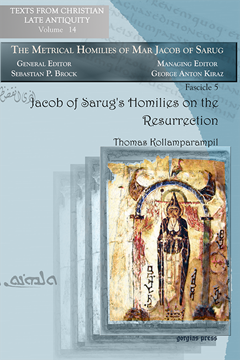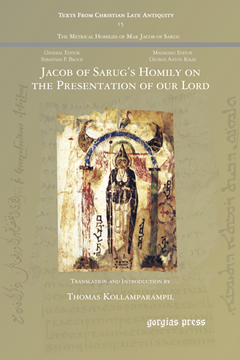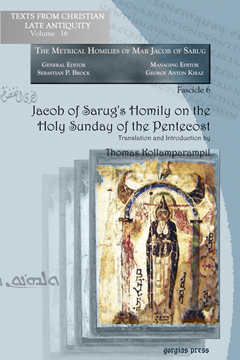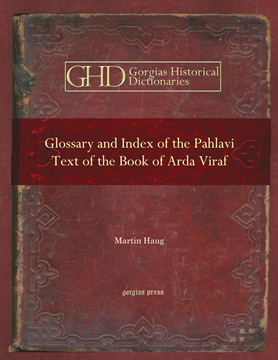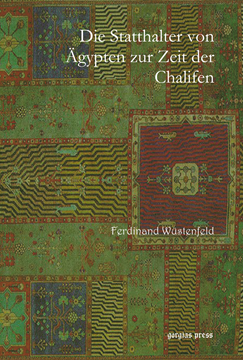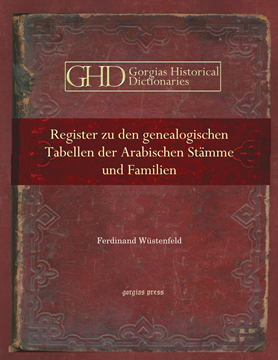Jacob of Sarug’s Homilies on the Resurrection
Metrical Homilies of Mar Jacob of Sarug
Translation and Introduction by Thomas Kollamparampil
Series: Texts from Christian Late Antiquity 14
ISBN: 978-1-59333-935-7
This edition of Mar Jacob of Sarug's (d. 521) homilies on the Resurrection contrast the Friday of sufferings and the Sunday of resurrection. At the resurrection heaven and earth become reconciled, Sheol is uprooted, and the tomb of the Bridegroom becomes the bridal chamber. The volume constitutes a fascicle of The Metrical Homilies of Mar Jacob of Sarug, which, when complete, will contain the original Syriac text of Jacob's surviving sermons, fully vocalized, alongside an annotated English translation.
$35.00 (USD) $21.00 (USD)
Jacob of Sarug’s Homily on the Presentation of our Lord
Metrical Homilies of Mar Jacob of Sarug
Translation and Introduction by Thomas Kollamparampil
Series: Texts from Christian Late Antiquity 15
ISBN: 978-1-59333-936-4
This edition of Mar Jacob of Sarug's (d. 521) homily on the Presentation of our Lord in the Temple develops the character of Simeon. The author himself asks Simeon how we should understand his supplication. Simeon explains his wonder at Jesus offering the turtle doves, creatures which Jesus himself fashioned with the Father, presaging Jesus’ self-offering. The volume constitutes a fascicle of The Metrical Homilies of Mar Jacob of Sarug, which, when complete, will contain the original Syriac text of Jacob's surviving sermons, fully vocalized, alongside an annotated English translation.
$32.00 (USD) $19.20 (USD)
Jacob of Sarug’s Homily on the Holy Sunday of the Pentecost
Metrical Homilies of Mar Jacob of Sarug
Translation and Introduction by Thomas Kollamparampil
Series: Texts from Christian Late Antiquity 16
ISBN: 978-1-59333-937-1
This edition of Mar Jacob of Sarug's (d. 521) homily on Pentecost draws a comparison between the Upper Room where the disciples receive the Holy Spirt and the Tower of Babel. The division of the tongues at Babel was a sign that the Good News would be spoken in all tongues. The One who divided the tongues at Babel gave the tongues of fire as well. The volume constitutes a fascicle of The Metrical Homilies of Mar Jacob of Sarug, which, when complete, will contain the original Syriac text of Jacob's surviving sermons, fully vocalized, alongside an annotated English translation.
$31.00 (USD) $18.60 (USD)
Glossary and Index of the Pahlavi Text of the Book of Arda Viraf
By Martin Haug
Series: Kiraz Historical Dictionaries Archive 18
ISBN: 978-1-59333-938-8
For the student of ancient Iranian documents, this time-honored source for using the sacred texts of the Zoroastrians, this glossary and index is an historical dictionary of an unusual sort. The materials from three works provide the basis for this glossary: the Pahlavi text of Arda Viraf, the tale of Gosht-I Fryano, the Hadokht Nask, and extracts from the Din-Kard and Nirangistan. All of these documents pertaining to Zoroastrian belief and practice are facilitated by this historic glossary. Based on the edition of E. W. West, the text was revised by Martin Haug. A work of scholarly erudition in the nineteenth century, this book, now difficult to find, has now claimed a place among Gorgias Historical Dictionaries.
$172.00 (USD) $103.20 (USD)
Die Statthalter von Ägypten zur Zeit der Chalifen
ISBN: 978-1-59333-939-5
An original exploration into the governors of Egypt under the caliphs, this seminal study of Wüstenfeld has remained essential reading on the topic since its original publication in the 1870s. Originally published in four parts, this edition contains the entire study in its original German. A thorough and meticulous record of the rulers of Egypt during the period of the caliphs, this book should not be overlooked by students of the Islamic culture of Egypt. Written from a lifetime of study in the field, Wüstenfeld’s sharp outlines of the governors and their influence in the growth and development of Egypt under Muslim leadership hold an authority and insight that make the book a desirable addition to the library of Arabists and scholars of Egypt alike.
$144.00 (USD) $86.40 (USD)
Register zu den genealogischen Tabellen der Arabischen Stämme und Familien
mit historischen und geographischen Bemerkungen
Series: Kiraz Historical Dictionaries Archive 21
ISBN: 978-1-59333-940-1
In an historic attempt to map out the major tribes and families of the Arabic world, Wüstenfeld prepared this work based on three major types of documents. Taken together these sources provide a wealth of information on family names. Wüstenfeld has organized the entries for his register alphabetically, providing a starting point for current day researchers on the Arabic past.
$204.00 (USD) $122.40 (USD)
